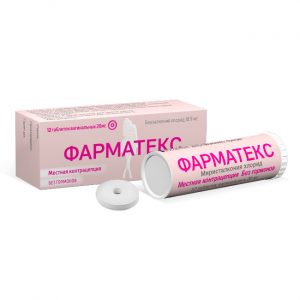Description
Latin name
Dalacin
release form
Cream vaginal
Indications
Bacterial vaginosis.
Contraindications
Hypersensitivity to clindamycin, lincomycin or any component of the drug Dalacin.
Use during pregnancy and lactation
Adequate and well-controlled studies on the use of the drug in the first trimester of pregnancy have not been conducted. The use of Dalacin in the first trimester of pregnancy is possible only if the intended benefit outweighs the potential risk to the fetus.
When using clindamycin preparations in the II and III trimesters of pregnancy in dosage forms for intravaginal administration, there was no increase in the frequency of congenital malformations of the fetus. If Dalacin is used in the II and III trimesters of pregnancy (although there have been no official studies on the use of suppositories during pregnancy), an unfavorable effect on the fetus is unlikely.
There are currently no data on the excretion of clindamycin with breast milk with intravaginal administration of dalacin. However, it was found that when clindamycin is administered orally or parenterally, a certain amount is found in breast milk. Therefore, when deciding on the possibility of prescribing Dalacin during lactation (breastfeeding), the expected benefit for the mother and the possible risk for the child should be compared.
Composition
1 g of cream contains clindamycin (as clindamycin phosphate) – 20 mg
excipients: sorbitan monostearate polysorbate 60 propylene glycol stearic acid cetostearyl alcohol cetyl palmitate mineral oil benzyl alcohol purified water
Dosage and administration
A single dose (1 full applicator (5 g of cream, approximately 100 mg of clindamycin) is injected into the vagina at bedtime for 3 consecutive days. The cream can be administered for 7 consecutive days.
Side effects
The incidence of the following side effects is less than 10%.
From the reproductive system: irritation of the mucous membrane of the vulva and vagina, vaginal pain, vaginal discharge, vaginal candidiasis, vulvovaginitis, trichomonas vaginitis, vaginal infections, menstrual irregularities, uterine bleeding, abnormal births, endometriosis.
From the urinary system: dysuria, urinary tract infections (including pyelonephritis), proteinuria.
From the digestive system: generalized abdominal pain, localized abdominal pain, abdominal cramps, bloating, dyspepsia, nausea, vomiting, diarrhea, constipation, flatulence, halitosis, taste perversion.
From the side of the central nervous system: dizziness, headache.
Dermatological reactions: rash, pruritus, maculopapular rash, erythema, skin candidiasis.
Allergic reactions: urticaria.
From the endocrine system: glucosuria, hyperthyroidism.
From the whole organism: fungal infections, fever, side pain, back pain, lower abdominal pain, generalized pain, bacterial infections, inflammatory edema, upper respiratory tract infections, nosebleeds, deviation of the results of microbiological analyzes from the norm.
Local reactions: itching and pain at the injection site.
Drug Interaction
In vitro, an antagonistic interaction between clindamycin and erythromycin has been demonstrated.
It has been established that clindamycin disrupts neuromuscular transmission during systemic administration, thus enhancing peripheral muscle relaxant action. This fact should be taken into account when appointing the latter with Dalacin.
In pharmacodynamic, no interactions were observed in pharmacokinetic or clinical studies of these dosage forms.
Storage conditions
The product should be stored out of the reach of children at a temperature not exceeding 25 ° C. Do not freeze.
Shelf life
2 years.
Active ingredient
Clindamycin
Terms and conditions
without prescription
Dosage form
cream vaginal
Prescribing
Prescribing
Adults, For women




